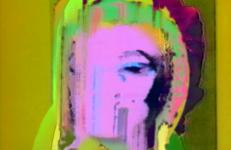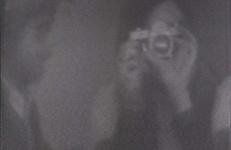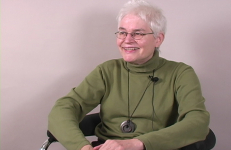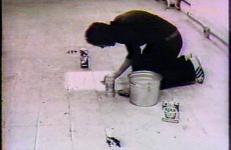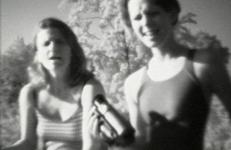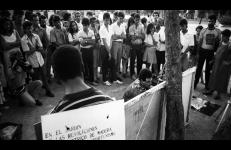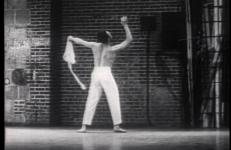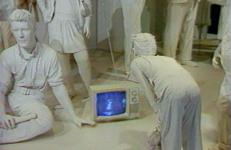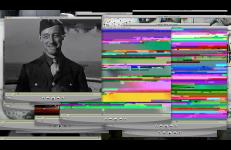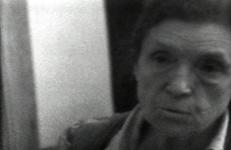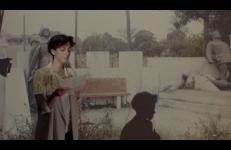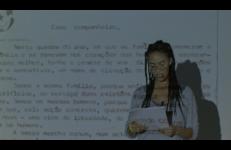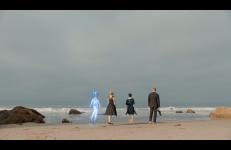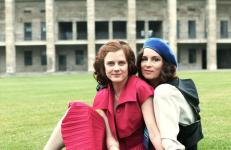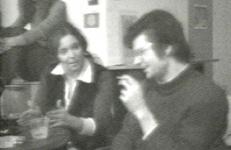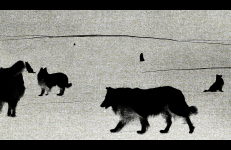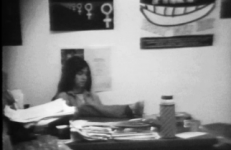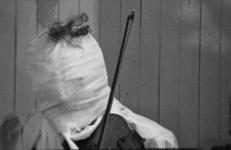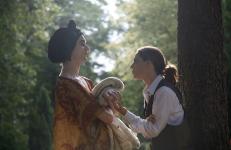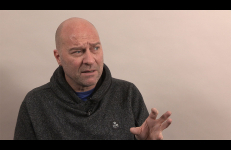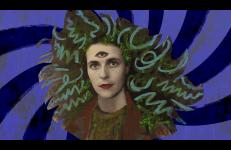2001 Colours Andy Never Thought Of transforms Warhol’s infamous screen prints of Marilyn Monroe through a process of color manipulation. The viewer witnesses a flurry of changing tones, colors, and shades in a postmodern nod to the scratch genre that Barber came to define.
Art History
This title documents the participation of artist Aldo Tambellini at the opening of the 1970 exhibition Vision and Televison. Held at the Rose Art Museum of Brandeis University in Waltham, Massachusetts from January 21st to February 22nd, the exhibition is widely regarded as the first museum exhibition of artist's video. Tambellini (b. 1930) was a pioneer of expanded media in the 1960s, and one of the first artists to use video and television as a medium.
The title is comprised of the following Videofreex reels:
The word-based art and performances crafted by world-renowned artist Alison Knowles (b.1933) are central to the 1960s international Fluxus movement and its enduring legacy. Describing her experience as a student at Pratt University in the 1950s where she learned from Richard Lindner and Adolf Gottlieb, Knowles recalls her transition from Abstract Expressionist painting to the chance operations initiated by John Cage and Bertolt Brecht.
This video presents a history of alternative spaces in New York City during the late 1960s and early 1970s, focusing on two galleries that no longer exist. The work produced in these two spaces forms the basis of the New Museum of Contemporary Art’s 1981 exhibition Alternatives in Retrospect: An Overview 1969-1975. Curator Jacki Apple, who produced the video, assembled documentation from the galleries and reconstructed artworks for the exhibition.
A found footage film with no found footage. A study in aphorisms: The Sad Tropics, un-attributed master paintings and mis-attributed artifacts alongside the history of denim. Signs, myths and legacy are questioned and revised.
This work attempts to further the critical dialogue surrounding the strategies of repetition and re-enactment. The Apparent Trap is a work that reminds the audience of the psychoanalytic implications of these strategies. It examines Walt Disney’s The Parent Trap (1961), a story in which twins decide to switch identities. The conceit of identity, the violence that erupts when one is confronted with one’s mirror image, and the “trap” of identification with the Other are all themes explored by re-enacting selected video art that speaks to these issues.
“In her brilliant video Art Herstory, [Freed] has restaged art history, putting herself in the model’s role in numerous paintings.... Time dissolves under her humorous assault — one moment in the painting, then out of the canvas and into that period, then back in the studio."
— Jonathan Price, “Video Art: a Medium Discovering Itself,” Art News 76 (January 1977)
An excerpt of this title (14:49) is also included on Surveying the First Decade: Volume 1.
This documentary explores the groundbreaking street performances of Cuban artist JuanSí González during the 1980s. A pioneer of relational aesthetic practice in Cuba, González transformed public spaces in Havana into laboratories for edgy exchanges between artists and the public and created numerous works that threw art's role in a socialist society into question. His experiments provoked surprise from his peers and suspicion from state authorities. Twenty years later, the artist sat down to reflect on the relevance of those performances for the development of Cuban contemporary art.
This video features California artists: drawer and painter Deanne Belinoff, sculptor and poet Sana Krusoe, wood relief carver and painter Palema Holmes, and New York-based video artist Shirley Clarke.
The Artists: Part 1 was produced in concert with the exhibition Four Solo Exhibitions at the Long Beach Museum of Art in 1988. The artists are introduced by LBMA’s senior curator Josine Ianco-Starrels. The video presents and contrasts the diverse styles, media, and personalities of these four women artists.
Commissioned by the Oakland Museum, this video provides an artist’s interpretation of the museum’s displays and collections. The voice of a friendly narrator enlarges the image-objects with historical and social information, while a written text provides ironic commentary. “The term curator is derived from the Latin ‘curatus’ —one responsible for the care of souls.” The daughter represented in the famous Dorthea Lange photograph of the Migrant Mother recounts the circumstance surrounding the now-celebrated photograph and how it impacted her life.
The city of Kinshasa and its liberation architectural spaces are here embodied through a journey of a woman that walks alone through the ghosted spaces of history. The spaces represented in the film build on heritage built before and after the wars of independence to signal the appropriation and resignification of power dogmas and canons of beauty and Hellenistic aesthetics through the presence and the protagonist of the black woman.
Big_Sleep™ explores problems in our archival urges. Via a single-channel desktop screencast, informatic elements ebb and flow—creating and relating interface absences. These gaps suggest that no amount of hard drive space can defy mortality.
Big_Sleep™ explores problems in our archival urges. Via a single-channel desktop screencast, informatic elements ebb and flow—creating and relating interface absences. These gaps suggest that no amount of hard drive space can defy mortality.
Louise Bourgeois (1911–2010) utilized wood, metal, plaster, and bronze in creating her sculptures. Among the many themes in her work are the house (or lair), the spider and the so-called “toi-et-moi” or “you and me.” These subjects derived from a self-defined problem in Bourgeois’s life, the desire to find and express a means of getting along with other people. For Bourgeois, the relationship of one person to another was all-important, and life had little meaning without it. Louise Bourgeois’s remarkable career spanned both the modern and postmodern eras.
Cacheu is a 10-minute shot of a lecture, performed by Joana Barrios, revolving around four colonial statues, which are stored today at the Fortress of Cacheu, one of the first bastions constructed by the Portuguese in 1588 in order to facilitate slave trade in the West African country of Guinea Bissau. Barrios evokes symbolic conflicts by tracing back different contexts in which the statues make an appearance: on a pedestal during Portuguese colonialism, dethroned and broken in pieces after Independence in the film Sans Soleil by Chris Marker, as background ghosts in Mortu Nega by Flora Gomes, and finally displayed at the Cacheu fort. The montage is a process that takes place before shooting, so that the image production is a result of a performative assemblage between text, acting, projected image and the framing of the camera by the director of photography, Matthias Biber.
Staged at the Haus der Kulturen der Welt, Berlin, Conakry is a sequence shot on 16mm film that travels through time, space and media to revisit one film reel from the Guinean archive. This particular reel documents an exhibition curated by Amílcar Cabral at the Palais du Peuple in 1972 in Conakry, Guinea, reporting on the state of the war against Portuguese rule. César invited the Portuguese writer Grada Kilomba and the American radio activist Diana McCarty to reflect on these images and their history.
Contra-Internet: Jubilee 2033 is a re-imagining of scenes from filmmaker Derek Jarman’s 1978 queer punk film Jubilee, starring Susanne Sachsse and Cassils. Contra-Internet: Jubilee 2033 follows author Ayn Rand (Susanne Sachsse) and members of her Collective, including economist Alan Greenspan, on an acid trip in 1955. Guided by an artificial intelligence named Azuma, they are transported to a dystopian future Silicon Valley.
1933. Berlin. The last year of the Wiemar Republic. Through the lense of her personal "home movies", Leni Riefenstahl records a day in her life with a young Eva Braun.
Die Neue Frau is the third film in the The Surface Tension Trilogy, a three-part short film trilogy looking at queer artists living in Berlin during the 1920s. Shot on hand-processed 16mm film.
In this rare and humorous record of the art dialogue of the late 1960s, Holt and "guest" Robert Smithson assume opposing artistic viewpoints: the uptight, intellectual New Yorker versus the laid-back Californian. Their play-acting lays bare the cliches and stereotypes of a "bi-coastal" art world. While Holt stresses analytic, systematic thinking, Smithson represents the polar opposite, privileging visceral experience and instinct, saying, "I never read books; I just go out and look at the clouds." and "Why don't you stop thinking and start feeling?"
A silent film essay considers the production of Robert Flaherty's seminal 1922 documentary, Nanook of the North (also known as, A Story Of Life and Love In the Actual Arctic). An image by an Inuk artist is discovered “missing” from the Museum of Modern Art (MOMA) collection.
In 1975, the Feminist Studio Workshop (I was a member) at the Woman’s Building in LA, the Women’s Interart Center in New York City, and another feminist organization in Washington DC, attempted to set up a video exchange among feminist art organizations. This was the first videoletter on our end. I don’t know if another one was ever made.
The videoletter is a tour of the Woman’s Building. Pam McDonald, with microphone in hand, another workshop member, and myself, served as guides through the building. It was shot with a black and white video portopack.
In a radical action like Nam June Paik destroying a violin, and rolling up in bandages the bodies of the players in in a concert by Yoko Ono, the international avant-garde group Fluxus changed not only art, but the concept of it.
Shot in the style of a silent film from the 1920s, Frida & Anita is a political fantasy, intersecting the lives of two queer radicals — Frida Kahlo and Anita Berber — who happen to meet one fateful Berlin night in 1924 at the infamous La Garcon Cabaret.
In this 2014 interview, South African artist Kendell Geers (b. 1968) discusses the function of magic, myth, and memory in his work. Beginning at childhood, Geers charts the path he has taken in his understanding of his own biography as a site of resistance. This interest in the use of personal biography culminated in 1993 with his decision to change his date of birth to May 1968 as a way to reference both the May 1968 student protests, and the fact that 1993 was the first year that South Africa had participated in the Venice Biennale since 1968.
In 1971, graduate student Gloria Orenstein receives a call from surrealist artist Leonora Carrington that sparks a lifelong journey into art, ecofeminism, and shamanism. A wife and mother of two writing her dissertation for New York University, Orenstein never expects to have her life transformed through female friendship.




